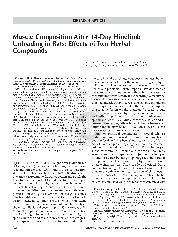摘要
Aim: We studied the potential of two herbal compounds (HC-1 and HC-2) in different dosages (HC-1, containing ligustrazine; HC-2, containing radix astragali) as a countermeasure against muscle atrophy in a hindlimb unloading rat model. Soleus muscle weight, fiber type distribution, cross-sectional area (CSA), and myosin ATPase activity were measured. Methods: Six rats each were assigned to a nine-group design: Control (CON); hindlimb unloading only (HLU); hindlimb unloading plus intragastric water instillation (HLU-W); and hindlimb unloading plus different dosages of instilled HC-1 (HLU-HC-1(1), HLU-HC-1(m), HLUHC-1(h) h) or HC-2 (HLU-HC-2(I), HLU-HC-2(m), HLU-HC-2(h)). Results: As expected, in HLU and HLU-W, soleus muscle-to-body weight ratio and CSA of type I and 11 fiber went down, and myosin ATPase activity and the percentage of type 11 fibers went up, all compared with CON. Compared to untreated rats, high-dose HC-1 enhanced type I and 11 fiber CSA by 77% and 55%, respectively; myosin ATPase activity (type 11 fiber percentage) were lower, but soleus muscle-to-body weight ratio did not change. High-dose HC-2 enhanced soleus muscle-to-body weight ratio by 33%; and type I/type II fiber CSA by 143% and 83% above HLU-W values, respectively, and resulted in a slower myosin ATPase activity (corresponding to a lower type 11 fiber percentage). Low- to mid-dose HC-1 and HC-2 showed some preventive effects as well. Conclusion: HC-1 and HC-2 in proper dosages diminished muscle atrophy that otherwise occurs in simulated weightlessness.
